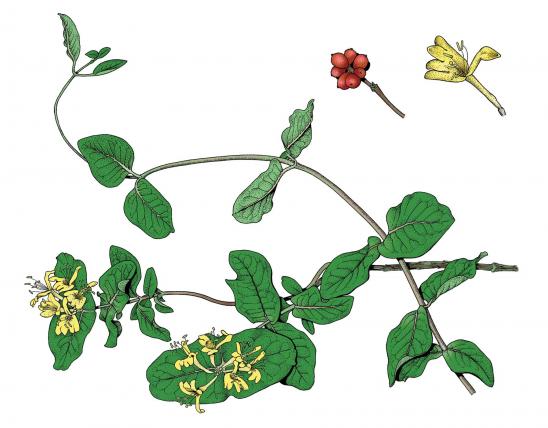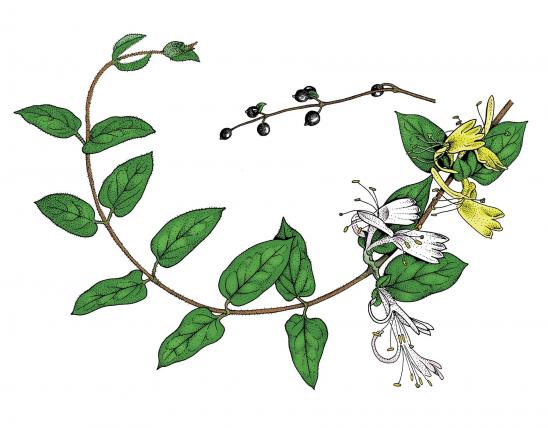
Ladies’ eardrops is a perennial, tendril-climbing woody vine to 40 feet, with green to reddish-brown stems. Usually, the stems are only woody toward the base. Often, this plant spreads across soil or water and roots at the nodes, but it also climbs on other plants, telephone poles, and other objects.
Leaves are alternate, simple, 1¼–6 inches long, ½–3 inches wide, thin, egg-shaped to lance-shaped; margins entire; upper surface light green, smooth; lower surface smooth or slightly hairy. Leaf stalk is ¼–1 inch long, somewhat expanded at the base and partly sheathing the stem.
Stems are high-climbing, sometimes up to 40 feet; green to reddish brown, finely grooved, with older stems up to 1 inch across. Delicate tendrils arise at the axils. There are no prickles.
Flowering is in May–August. Flowers are greenish, minute, in clusters 2–10 inches long at the end of stems; petals absent; sepals are petal-like, 5-parted.
Fruits mature August–October. Fruits are pink, showy, hardened, drooping, leathery, ¾–1½ inches long, the upper half with the remains of the 5 sepals, the lower half flattened into a wing with a ridge on one side. The seed is tightly enclosed.
Stems can reach nearly 50 feet in length.
Scattered to common in the Mississippi Lowlands (Bootheel). Missouri, Arkansas, and the southern tip of Illinois represent the northwestern edge of this species’ range, which centers in the lower Mississippi River valley.
Habitat and Conservation
Occurs in swamps, bottomland forests, and banks of sloughs and oxbows; also ditches, fallow fields, crop fields, roadsides, and moist, disturbed areas.
Status
This plant is in the smartweed family, which includes smartweeds, docks, true sorrels, knotweeds, and wild buckwheats. Sea grape, rhubarb, and buckwheat are economically important human food plants in this family. Beekeepers appreciate them as honey plants. On the negative side, many members of the Polygonaceae are serious crop weeds or exotic invaders of native plant communities. Some of them produce chemicals that suppress germination and growth of other species nearby.
Human Connections
The fruits somewhat resemble ear pendants because of their long, narrow wings, hence the common name. These interesting, persistent fruits could make this a decent candidate as an ornamental vine on an arbor or trellis, but it may be aggressive in moist, fertile sites.
This species sometimes can be a problem weed in crop fields, particularly in soybeans. It is relatively resistant to glyphosate herbicides and thus grows well amid glyphosate-resistant (transgenic) soybeans. However, because ladies’ eardrops has fairly fine roots, deep-tilling the soil before crop planting can reduce infestations markedly.
The genus name honors the 18th-century Danish naturalist Morten Thrane Brünnich.
Ecosystem Connections
The fruits of many species in the smartweed family are important migration foods for many types of waterfowl.
There are doubtless at least some butterflies, moths, or skippers that use this species as a larval food plant.
As a rapid colonizer in barren, low areas, this plant helps to bind soils, and it certainly must provide shelter for insects and other small animals.
































